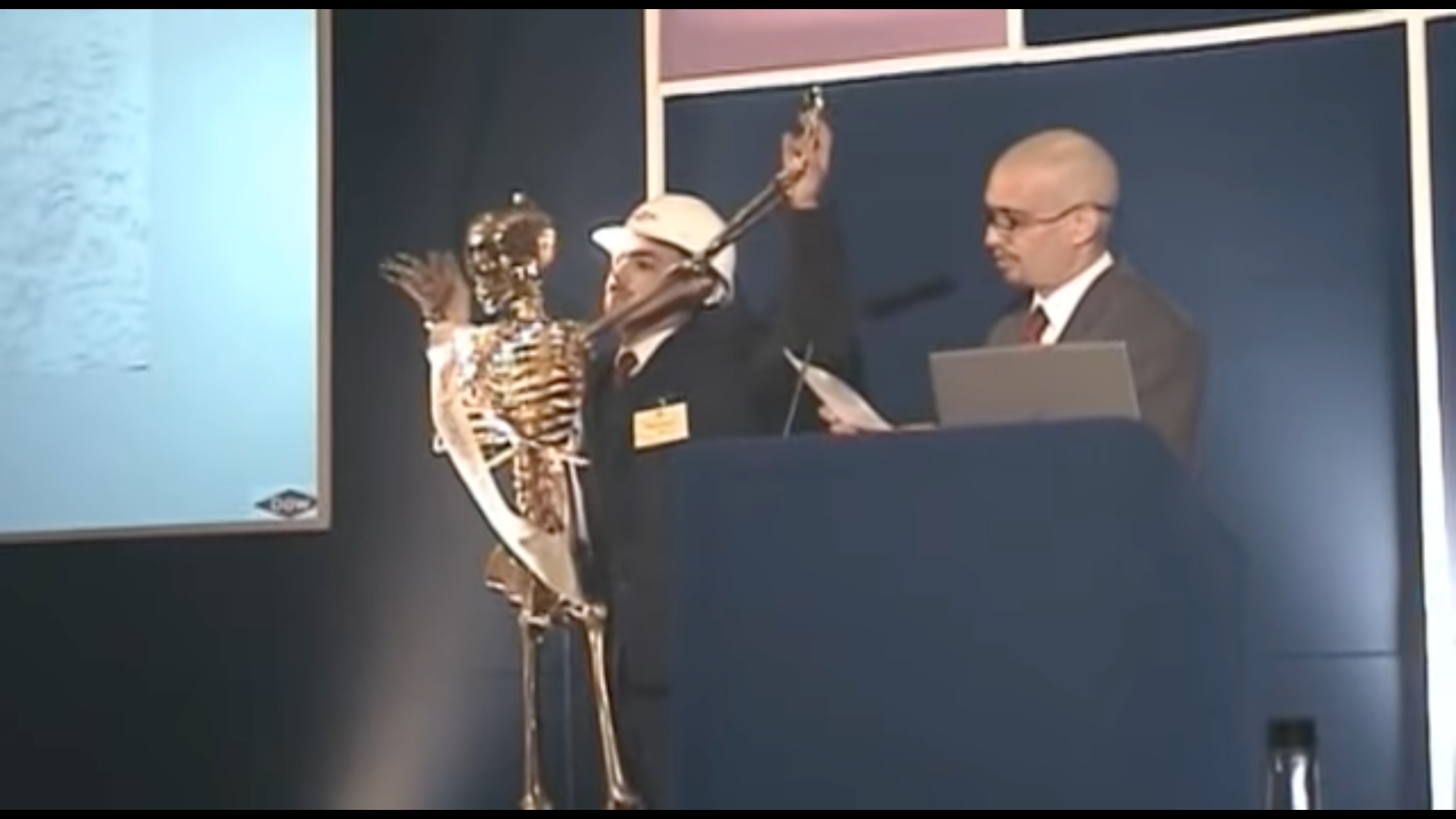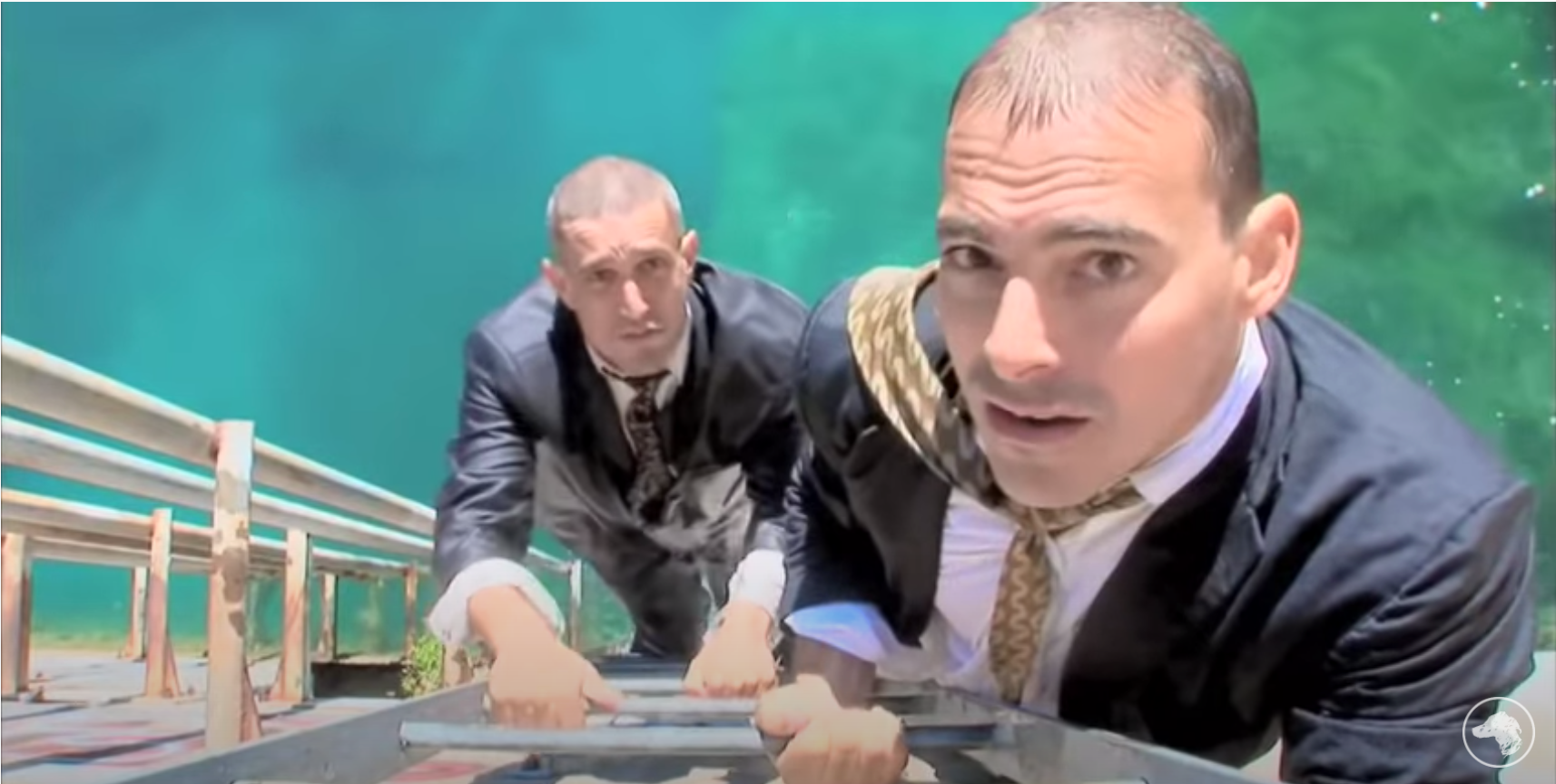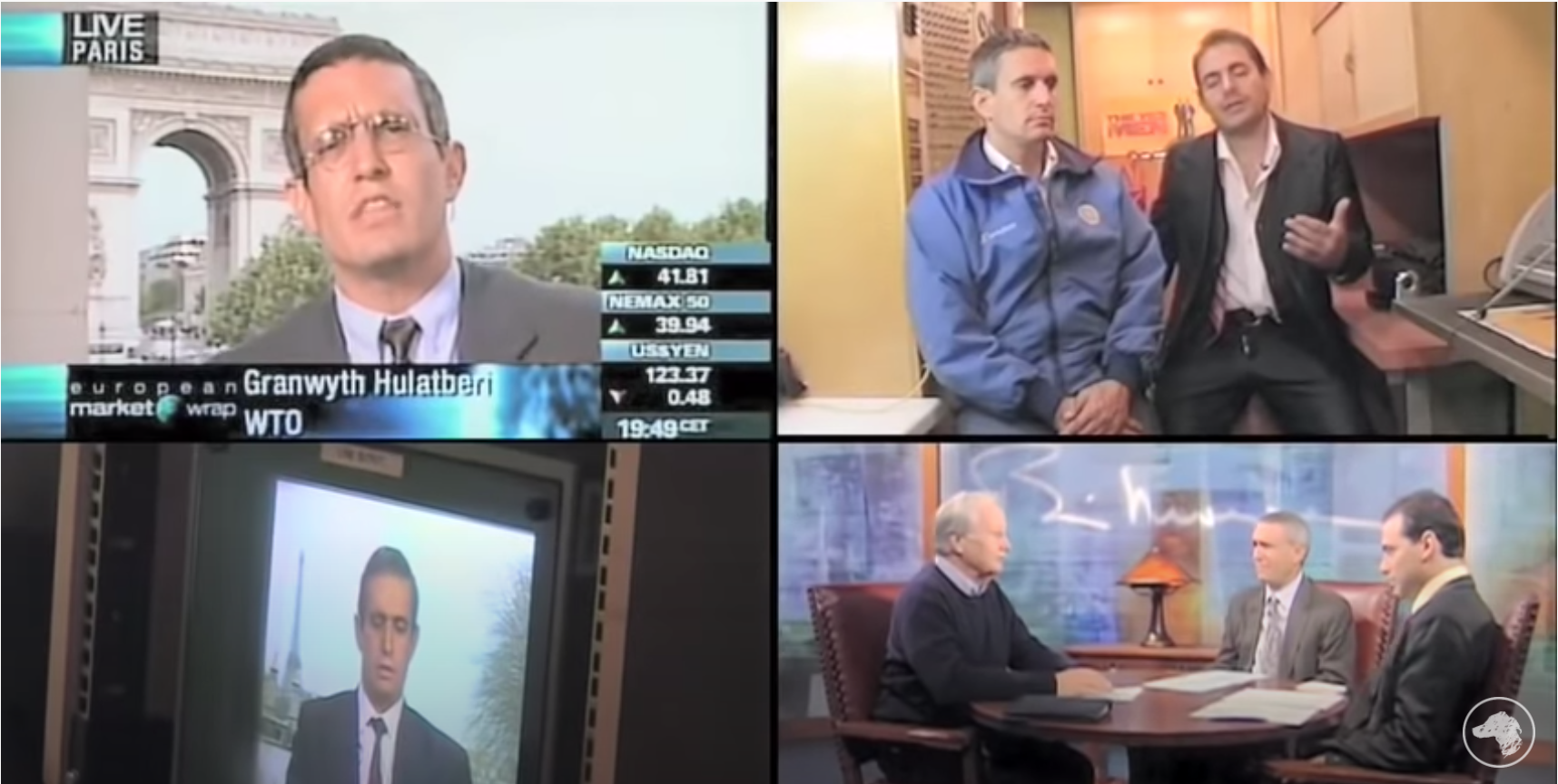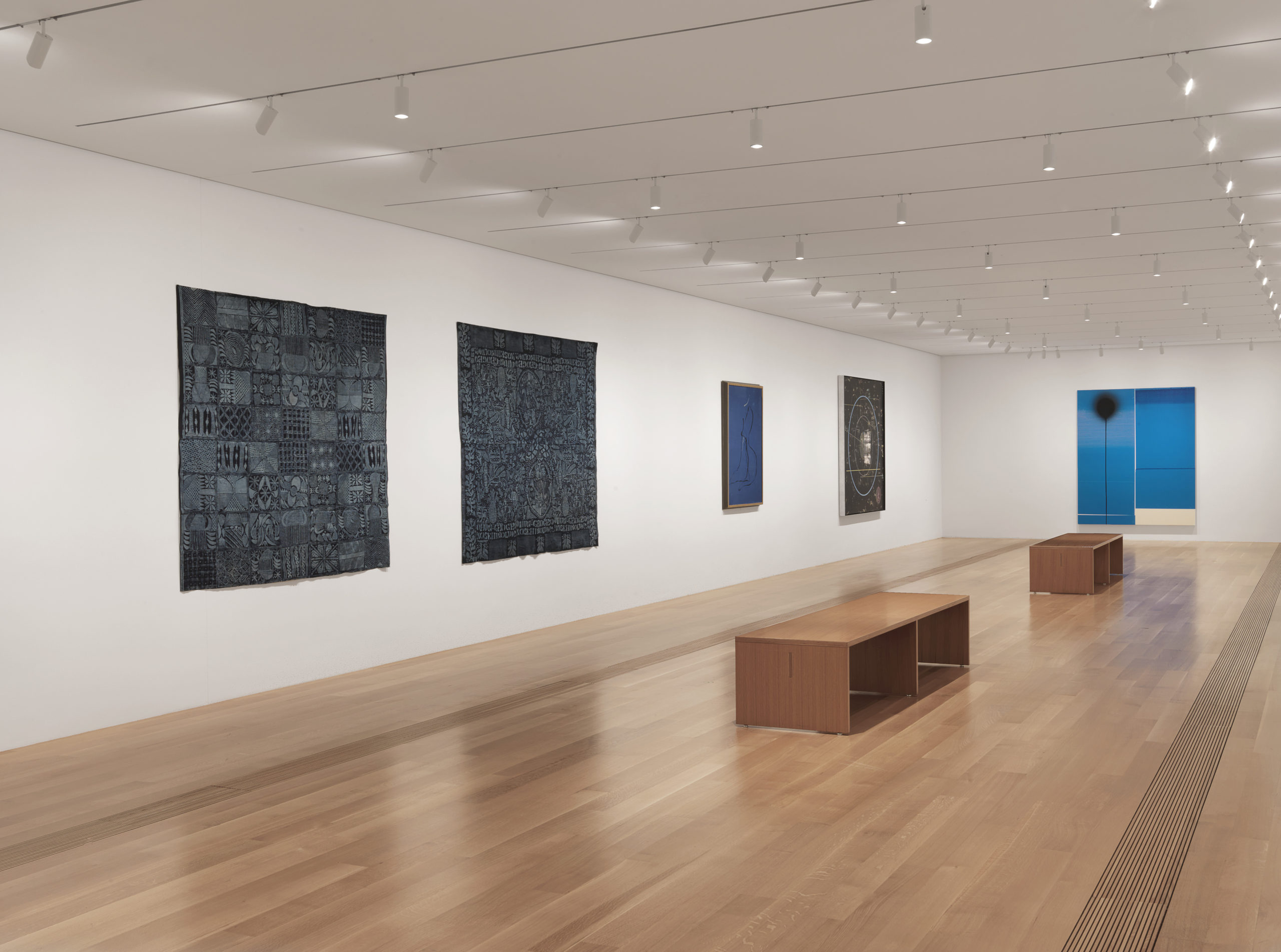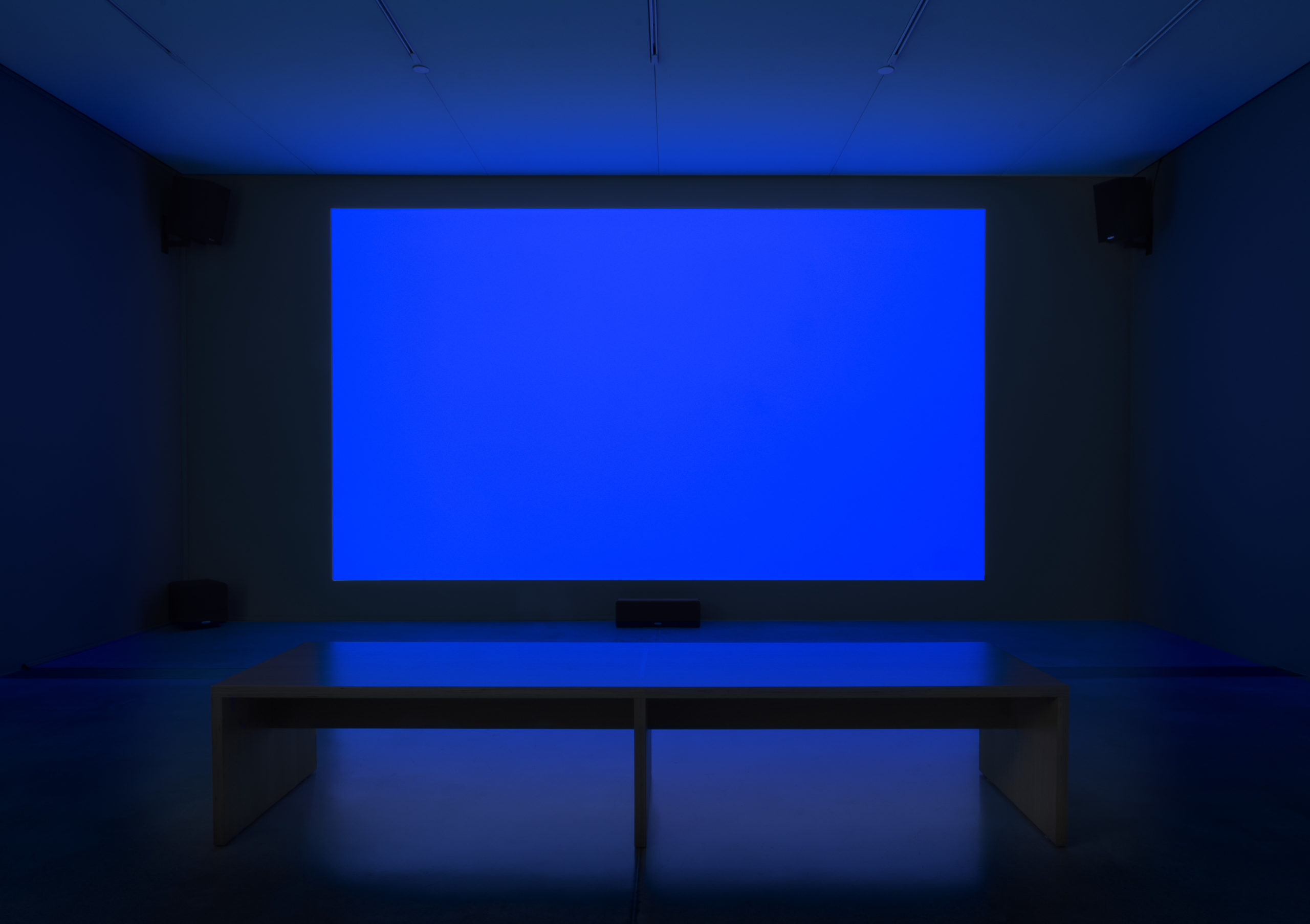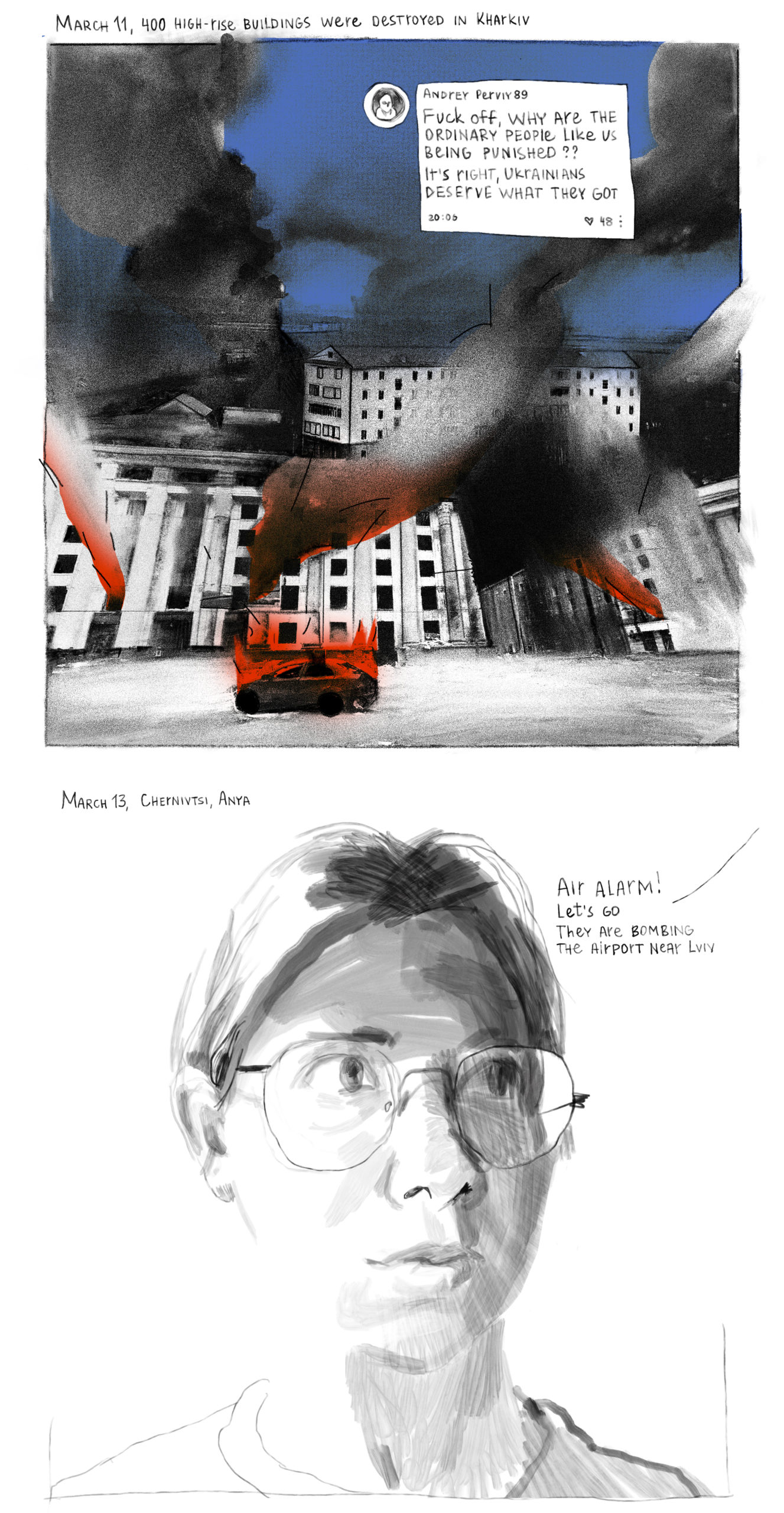Broken Hum(or)

The Yes Men Fix the World, 2009, screenshot [courtesy of YouTube and Dogwoof]
Share:
I seem to have lost my sense of humor. If you find it, that’s okay. I don’t actually want it back.
I grew up listening to my parents listen to Tom Lehrer, the Ivy League mathematician turned satirical songwriter, whose sendups of nuclear proliferation, World War III, and masochism—among other things—provided great levity for my professional parents and their friends as they sipped drinks in the living room. In some of my early memories, I sit on the floor of my room, spinning Lehrer’s vinyl on my children’s record player, the Red Raven Magic Mirror spindle reflecting the label in a blur of color. I was a six-year-old, processing quips such as “a young necrophiliac who achieved his childhood ambition by becoming coroner” or little ditties such as the one about a girl who did in her family. I learned to get the irony, to find it fast, in any context. I received an early education in snark and parody, and I internalized the basic lesson, which I’ve carried with me all my life: everything is funny, and if you can’t laugh at it—whatever “it” happens to be, especially whatever unpleasant situation you find yourself in—you’re not okay.
In his 1998 social violation theory of humor, the linguist Thomas C. Veatch proposed that laughter is caused by an “affective absurdity.” Some emotionally powerful aspect of a situation is at odds with, or violates, its perceived rightness—its “subjective moral principle”—but simultaneously and ludicrously, the situation is seen/presented as normal. Such incongruity is also, of course, a cause for tears. Contradiction—not just mapped over consonance, but residing within it—is the basis of parody, ironic play, culture jamming, and irreverent “artivism.” The logic of socially or politically useful parody asserts that, by extricating the conflicted original from itself and presenting its mirror image—expanded and exaggerated to an obviously absurd extreme—the original’s flaws can be laid bare, that things can be re-visioned, hidden cruelties or stupidities can be revealed, and human beings can rethink their views. The argument, therefore, asserts that if the absurdity can be revealed as such, people will take action to change it—that seeing the absurdity is the missing ingredient in the recipe of change.
On the basis of this principle, I loved The Yes Men and their obvious, DIY satires of the World Trade Organization, Dow Chemical, and the like. They are gifted parodists whose innovative skill in mimicking websites and other identity markers has earned them unwitting invitations to speak on behalf of such organizations. Antic pranksters in thrift store suits with bad PowerPoints and Dickensian pseudonyms, The Yes Men, by assuming such fictional roles as “Erastus Hamm, a Dow representative,” for example, could convince a room of professionals at a 2005 London banking conference that large profits could justifiably absorb a certain number of human deaths.
The Yes Men Fix the World, 2009, screenshot [courtesy of YouTube and Dogwoof]
Invited to consider “acceptable human risk” with the visual aid of a cheaply made gilded skeleton—“Gilda, the golden skeleton in the closet”—participants applauded, signed up to receive the “Acceptable Risk Calculator,” and missed the obvious dark ironies of comparisons to Nazis and to the lives lost in the Bhopal chemical disaster. The joke was on them, and that was the funny part.
The Yes Men Fix the World, 2009, screenshot [courtesy of YouTube and Dogwoof]
But the assumption always loomed: By taking the affective absurdities within a situation to their extremes, someone, somewhere would open their startled, newly seeing eyes and begin to dismantle their selfishness, avarice, and abuses of power. We believed that such parodic artivist capers could save the world (The Yes Men called their 2009 documentary The Yes Men Fix the World, and sure, it was a joke, but only a little up-the-sleeve giggle). From the 90s through most of the 00s, media-savvy alternative movements mobilized their networks to establish parodic counterculture spaces, and they were early adopters of social media infrastructures. How else were we to get through the George W. Bush years if not by clowning the clown? Remember the carnivalesque joie de vivre of the Occupy Movement? And where have I put my TV-B-Gone—that little gadget by Mitch Altman, sold through Adbusters—that let me culture jam by turning off any TV, anywhere (though it no longer works so well, what with all those closed-circuit screens)?
Rather than gazing nostalgically at that time’s hopefulness, at more innocent but effective laughs, I’m describing an era’s generally shared assessment of humor’s value—especially parody—as a means of effective, destabilizing critique. Kate Kenny, for example, examined The Yes Men’s work in a 2009 article for Culture and Organization. The essay maintained that parody’s conjoined traits of humor and spectacle work to “critique some of the institutions we take for granted.” She acknowledges that parodies can be incorporated into the power structures they mimic, but nevertheless argued that “such acts of parody … highlight the constructed nature of commonly accepted identities …. In so doing, the comedic upturning enables us to hold these perceptions at a distance, to examine and critique them, and perhaps to imagine how things might be otherwise. If such acts are to continue, they must always be fresh, and always funny.” Thus, the humor is the crucial element regarded as transformative.
The Yes Men Fix the World, 2009, screenshot [courtesy of YouTube and Dogwoof]
More importantly, and more innocently, Kenny—like other cultural critics writing at the time—saw “the relatively new media of DVD and Internet provide … unique fora for such critical humour to proliferate.” Here, it is not the prank that allows for the possibility of socially effective parody, but the skillful deployment of new media platforms to disperse the spectacle over a widening field and turn up the heat on the targets of derision. As Joan Donovan put it in a recent article for Scientific American, looking back at such activist spectacle:
Techno-optimism … led activists to adopt Facebook, Twitter and YouTube alongside email lists, SMS text groups and livestreaming during the so-called Arab Spring, the Occupy Movement and the early iterations of Black Lives Matter. These networked social movements were multiplatform in several senses of the word: they existed on computational infrastructure that referred to itself as a tech platform where activists offered an alternative political platform geared toward social justice.
On the morning after Donald Trump’s election in 2016, I stood in a pool of sunlight at the window of a little rented kitchen in Prague, feeling as if a cloud of evil had landed on the planet. Not being a mystical person, I’ve tried to understand the reason for the persistent sense of desolation that descended then and hasn’t really lifted. Self-medicating by clicking on “Best of Late Night” in The New York Times every morning, through the Trump presidency, failed to offer any proof that I was okay just because I was laughing. Since the pandemic’s arrival, I’ve begun to feel increasingly uncomfortable with my old assumptions, not only about laughter, but also about the role of humor, spectacle, and parody in social change. As the politicized right has appropriated false narratives, as well as strategies of protest, I’ve grown leery and even anxious about anything not strictly earnest or forthright.
The Yes Men Fix the World, 2009, screenshot [courtesy of YouTube and Dogwoof]
In particular, I’ve wondered whether activist artists like The Yes Men, for example, created a monster. I’ve wondered what the proliferation of their techniques—not their ironic unveiling of injustices and illogic, but their promulgating of false narratives—has done to the entire conceptualization of humor, and whether the “social violation” model of humor has been weaponized, almost like chemical warfare, into a suffocating cloud of evil that could potentially choke us all. Maybe something has fundamentally changed in the last decade that alters the way I understand what’s funny. It’s time to consider an alternative paradigm
But in an era when nothing is what it seems, during which men in costumes—such as, for example, Viking horns, body paint, and a flag cape—can storm the United States Capitol in hopes of preventing a presidential election from being certified, I have glimpsed some reasons why my intrepid sense of humor is cowering elsewhere.
I’m not alone in having these thoughts. Lindy West’s essay “Is Adam Sandler Funny?” reexamines an exhaustingly large portion of Adam Sandler’s film oeuvre. The essay interrogates “the Adam Sandler Adam Sandler movies … the ones where [he] does the voice and [his] friends are played by those three dudes.” Her writing is motivated by West’s curiosity about what she once found so funny in such films as Billy Madison—films from the star of so many Saturday Night Live episodes she had imbibed and internalized, the way I imbibed Tom Lehrer (though I imbibed SNL, too). “[It’s] hard to laugh at Sandler as an adult woman,” she writes, “when you’re suddenly, painfully aware of how he helped shape the adult men around you.” West’s view of Sandler’s quintessential “Sandler” films results in a seven-point taxonomy of qualities revolving around the idea that no matter how stupidly inept, inane, and unappealing Sandler is as a character—“a true bare-minimum kind of human”—he is, nevertheless, the best. West does not conclude with a reductive indictment of male entitlement; rather, she arrives at the sad observation that “the crux lies less in the movies themselves and more in the emptiness around them.”
Hannah Gadsby’s Nanette (2018), a televised version of her stand-up stage show of the same name, dramatically pivots from caustic, whip-smart jokes about the “hilarious” pain of being marginalized—of being okay because she can laugh at anything—to the earnest statement, “I do think I have to quit comedy, though …. I have been questioning this whole comedy thing. I don’t feel comfortable in it anymore.” Gadsby subsequently and poignantly describes the trauma she has experienced, and her refusal to participate any longer in self-deprecating humor, which is, after all, only another form of humor’s affective absurdity. Only, in this version, you are yourself the thing that violates “normal” and sparks the laugh. “You learn from the part of the story you focus on. I need to learn to tell my story properly,” she says, and she moves away from the punch line (do we ever think about the violence of that phrase, I wonder) toward an altered mode of connection and vulnerability. And no, it’s not funny—not in the ways we’ve grown accustomed to thinking about the comedic lens, which makes the shitty parts funny and pushes away any need to sit with that pain or expect the emptiness around us to behave tenderly toward it.
And what are The Yes Men up to these days? In August 2021, Yes Men member Andy Bichlbaum attempted to prank far-right commentator Tom Basile on his show America Right Now (NewsmaxTV). Rather than appearing as a fictional American Enterprise Institute “colleague” of Paul Wolfowitz, as intended, Bichlbaum—thanks to a series of last-minute tech miscues—had to pretend to be Wolfowitz himself, commenting upon the Biden administration’s withdrawal from Afghanistan. It was funny, of course, a pure Yes Men send-up of an ideological blindness so ridiculous and pervasive that Basile was willing to enthusiastically agree to Bichlbaum/Wolfowitz’s “brand-new ‘conservative angle’ for criticizing Biden’s withdrawal: that without a war—even a doomed and failing 20-year war—Americans have nothing to be proud of, since we lag so far behind other rich nations on health care, infrastructure, education, elder care, food options, income, social mobility, and so on.” The joke is on him, right? And that’s the funny part.
The Yes Men Fix the World, 2009, screenshot [courtesy of YouTube and Dogwoof]
In 2020, assessing reasons that the early prankish activism she called “techno-optimism” has waned, Joan Donovan draws very different conclusions from critics writing in the 2000s. She writes that, in the first decade of the 21st century, The Yes Men
devised a political education program, where many folks contemplated the use of hoaxing as a mechanism for social protest …. Now the field is open to any ideologically motivated group. Tactics include impersonating individual politicians, creating mass fake accounts, and coordinating the harassment of journalists and activists through the use of streaming platforms, chat rooms and message boards. Groups have also used automated posting to game algorithmic signals, as well as paid advertising tools to target vulnerable populations. Others have generated denigrating deepfakes. They also have adopted techniques to influence trending algorithms, as well as to circumvent content moderation.
Parodic spectacle has indeed created a monster. As Tom Lehrer once put it, “satire was made obsolete when Henry Kissinger got the Nobel Peace Prize.” When carnival is the norm, when the exaggerated ironic double exists not to make us re-vision the original but to newly violate the normal, when potentially anything and anyone is a stubbornly deliberate embodiment of parodic exaggeration (Marjorie Taylor Greene, anyone?), there’s not so much reason for laughter as there is for something bordering on hysteria. I continue to find myself not amused by much of anything.
As I have stopped laughing, I’ve wondered what might replace or at least complicate my deeply internalized sense that everything, looked at through a properly paradoxical lens, is funny. One possible model has been suggested through a return to the human body in Bakhtin’s ideas about carnival. The functions of the body—its shitting, pissing, burping, bleeding, its constant shedding of cells, its constant urge to return to the earth in death—suggests not scatological humor, but the underlying and shared vulnerability of all beings, the constant presence of the capacity to be wounded, to be bruised. This Bakhtinian re-visioning of humanism is not a return to discarded, self-justifying, anthropocentric humanisms of the past—defining human through various transcendent or ideological positions. Instead, it is a reconfigured necessity to be consciously motivated by the vulnerability of all beings, human and nonhuman—and extending to such living things as the climate, the oceans, etc. The dialogic interconnections among beings, in all their absurdity, returns me to the etymological links between earth, ground, and humility—though humor is etymologically closer to water and fluidity. These connections also take me away from the checked-out, detached ironies that have become so much a part of humor’s DNA, and toward a sense of humor that is attached to tenderness, to the capacity to be bruised.
Blue Black, a 2017 exhibition curated by Glenn Ligon for the Pulitzer Arts Foundation in St. Louis, offers a possible alternative for me. Exhibitions have a weak shelf life, but Blue Black has stayed with me, literally coming into my thoughts almost every day since the last time I saw it, on September 16, 2017.
Glenn Ligon, Blue Black, installation view, 2017 [photo: Alise O’Brien; courtesy of Pulitzer Arts Foundation]
That was the day after the Stockley verdict, which acquitted the White policeman who, in 2011, shot Anthony Lamar Smith—a day when St. Louis was a city with wounds newly reopened. With the exhibition’s inclusion of work by widely disparate people—54 works by artists who were female, male, LGBTQIA+, straight, Black, Asian, White, from the United States and elsewhere, well-known and obscure, spanning 90 years of artistic production, from 1927 to 2017—it was curated to be a touch point of vulnerability through various concepts of “blue.” Blue Black made me contemplate the concept of the bruise, the capacity to be wounded. The works in Blue Black appeared on the white walls of the Pulitzer’s elongated galleries like bruises upon the limbs of a body, as if a skin had been turned inside out. Viewing these works was like running a gauntlet of bruises, all lined up, all singing together in the key of blue, all letting the pain shine. It evoked pity—a delicate unwillingness to break or bruise another, whether human, animal, or object—because being broken, being bruised, bleeding internally could be seen as the primordial shared condition, within the blue shroud that is the earth.
Shortly after seeing Blue Black, early on a fall morning, I was running a back road on the pastoral campus of the college where I teach. Near St. Louis, the campus sprawls above the limestone bluffs on the Illinois side of the Mississippi River, so secluded that a solitary cougar roams the land, and especially on weekends you might see more deer than students. I was thinking about Blue Black as I ran. I had been trying to review the exhibition and was stuck. I was running, hoping to get unstuck, on one of those gray Midwestern mornings when mist conceals all distinctions between objects.
Out of this gray nothing a man appeared, a tall White man in hooded warm-ups with the name of a prominent, progressive college emblazoned on his chest. A coach, most likely, for a team taking part in a daylong athletic event elsewhere on campus, exploring the grounds. He stopped me to comment on the beauty of the place. Our isolation and cultural homogeneity were “a heritage worth preserving,” he said. I shrugged and told him I thought we needed more diversity, more inclusivity. “That would be a shame,” he replied, “especially when there are some people now who want to sweep White privilege aside.” I froze like a deer facing a predator, but he flipped a big hand in a dismissive gesture, smiled in a way that couldn’t quite conceal his sneer, said “You’ll figure it out,” and wandered back into the mist. I ran on, turning up the volume on my playlist, and Marvin Gaye’s Mercy Mercy Me flowed into my head: “Where did all the blue skies go? Poison is the wind that blows from north and south and east ….”
Ellsworth Kelly, Blue Black, 2000, painted aluminum panels, 336 x 70 x 2.13 inches [photo: Robert Pettus; courtesy of Pulitzer Arts Foundation]
The weight of the world feels heavier now than it ever has in my lifetime. I long ago learned to stop saying, “Things can’t get worse.” They can, and they do, and recently the sense of accumulating sorrow and horror has raised ever more urgently the crucial problem of how to live ethically and with grace amid hopelessness. Here, I think, is the reason that, for five years, I have been thinking almost daily of Blue Black. The exhibition tugs at my consciousness, images of its artworks and its installation float into my mind. Persistently, it invites me back, invites me in, and refuses to let me leave, because it had something to teach me about orienting, fundamentally, toward a bruised and bleeding world.
As Ligon put it in his exhibition essay, “In this turbulent moment in our history, we need art to speak, as much as we as citizens need to speak up.” Seen this way, works of art are not obscure inanimate objects—a flotsam and jetsam of culture—but active beings that, like the angel who wrestled and wounded Jacob, pierce you and cause you to struggle until your being is changed. This is what has happened to me with Blue Black.
And this is what happened to Glenn Ligon: He stood in front of Ellsworth Kelly’s Blue Black, which is permanently installed at the Pulitzer. Instead of a hard-edged vertical abstraction, consisting of a band of black below a band of blue, he saw the legacy of Black wounds.
Kelly’s painting poetically conjured, for Ligon, Fats Waller singing, “My only sin is in my skin/What did I do to be so black and blue?” Ligon saw Kelly’s “black and blue” and perceived the fundamental premise of the show: the ravages of race as the ideological and social stigma ascribed to skin color, along with the social, psychological, economic experience that accrues to it, constitute a basic mode of human vulnerability. The exhibition, and Ligon’s poetic insight, asked everyone to begin at this place, the place of shared woundedness, the capacity to be bruised.
Bryan Stevenson, writing in Just Mercy: A Story of Justice and Redemption, put it this way:
We are all broken by something. We have all hurt someone and have been hurt. We all share the condition of brokenness even if our brokenness is not equivalent …. But our brokenness is also the source of our common humanity, the basis for our shared search for comfort, meaning, and healing. Our shared vulnerability and imperfection [nurture and sustain] our capacity for compassion.
Yes, that’s the “funny”—as in odd or incongruous—part: Something in the affective situation violently upends what we regard as normal and causes us to recognize vulnerability.
I think this kind of funny is what Hannah Gadsby was getting at when she spoke of learning to tell her story properly. If the pervasive definition of humor—the one I absorbed as a child—has been about the medium of power, especially as White males of a certain generation defined it, then it is clear that this particular type of humor, which has dominated for a long time, now feels nasty and unnuanced. The social violation model of humor still works, but unmitigated, it obscures bad things with good jokes.
Derek Jarman, Blue, 1993, digitized 35 mm film [photo: Jim Corbett; courtesy of Basilisk Communications/Zeitgeist, and Pulitzer Arts Foundation]
Consider the voice in Derek Jarman’s Blue, included in Blue Black. It narrates a story without a punchline and without a happy ending. It invites me into a shared mortality. It is a voice of relentless compassion, entering my head as if it were my own—the first person “I” inviting me to hear more clearly than the eyes can see. Inside its blue shroud is tenderness, love, patience, concern, a sad acceptance—the things that matter, even if existence turns out to be a passing moment within a vibrating expanse. This voice, this blue, offers a way to live within the infinity of the transient, pain-filled present.
On March 18, 2022, Anya Ivanenko and Jenya Polosina published in Hyperallergic a comic titled The War in Our Country and on Our Phones. In softly drawn frames, imbued either with simple reds and blues or soft graphite tones, the images alternate between the brutalized Ukrainian landscape and people hunched in shelters, looking at cell phones. The human beings are diminished and vulnerable, surrounded everywhere by concrete, steel, machines, and mechanistic systems. The drawings show phone screens mediating the voices of sheltering Ukrainians’ acquaintances or family members in Russia. Little speech bubbles pop up in the frames to show, not punch lines, but the Russians’ confident, propaganda-fueled assertions that the war is not happening, and that their loved ones are safe—when they clearly are not. The comic reveals the affective absurdity of such manipulated beliefs in the midst of war.
Ivanenko’s and Polosina’s comic demonstrates the accuracy of Veatch’s social violation theory of humor and ironic paradox. It also bypasses spectacle and tells the story in a way that is accountable for trauma, the tenderness of the body and mind, their capacity to be harmed. It aligns with Gadsby’s observation that, “To be rendered powerless does not destroy your humanity.” We humans may die—we will, certainly—but if we die laughing, what would that look like?
A lot like crying, I suspect.
Anya Ivanenko and Jenya Polosina, The War in Our Country and on Our Phones, 2022 [courtesy of Hyperallergic]
Dinah Ryan is Cornelius Ayer and Muriel Prindle Wood Professor of the Humanities at Principia College. She has been a contributing editor for ART PAPERS since 1992.

